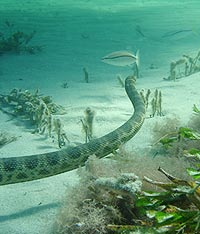
Research Projects – Escape Tactics and Predator Risk Effects

Escape Tactics and Context Dependence of Predator Effects
Our studies have shown that tiger sharks influence the behavior and habitat use of many species in Shark Bay, but one interesting discovery we have made by working on so many species at the same time is that the specifics of how each species deals with the risk of being eaten by a tiger shark in different ways. Although almost all species shift to using safer deep habitats when tiger sharks are around in the bay, those individuals that use the more dangerous shallow seagrass banks do so in different ways that sometimes are exactly the opposite of what we might expect.
Cormorants escape from tiger sharks by flying away.
Sea snakes have a hard time escaping from tiger sharks. They basically have to rely on not being seen - the best place to do that is to slither through the seagrass where they are virtually invisible - or swimming into the dense seagrass of an Amphibolis bed. Cormorants escape from tiger sharks by flying away. For both sea snakes and cormorants, it doesn't matter where they are over a bank - along the edge or in the middle - they have about the same chance of escaping from a tiger shark if they run into one. That means that to be safe they should try to avoid them as much as possible. This is exactly the pattern we see. When tiger sharks are not in the study area snakes and cormorants are found in equal densities in the middle of banks and along the edges, but when sharks show up they are most often found in the middle of banks where sharks are less common. We rarely see them along the bank edges where tiger sharks are commonly looking for food. Even though there is plenty of prey for snakes and cormorants along bank edges, they don't take the chance of running into a tiger shark

or over sand are easy prey for tiger sharks.

run into tiger sharks in the middle of a bank
have few escape routes

We might expect that dolphins and dugongs would make the same choices that cormorants and sea snakes make - if they are going to be in dangerous shallow waters they should quickly move into the middle of the banks. But, they do exactly the opposite! Like cormorants and sea snakes they use edges and bank middles about the same when tiger sharks are absent, but use bank edges almost exclusively when sharks show up. Why would these species congregate where they predators are more common? Are they ignoring the risk from tiger sharks? The answer lies in their escape ability and how effective it is along bank edges and in the middle of banks. Dolphins, dugongs, and green turtles are better at maneuvering underwater than tiger sharks. That means that if the water is deep enough, they are very likely to get away from a shark once they see it if they are close to deep water or it is deep enough over a bank. In the middle of banks, where the water is shallow, escape is less likely so even though a dolphin or dugong might be less likely to run into a shark in the middle of a bank they are more likely to get eaten if they do. Because of their greater ability to escape when they are along the edges of banks, dolphins, dugongs, and green turtles in good body condition all prefer to reside along the edges of banks when tiger sharks are present! This means that tiger sharks may actually cause these prey species to congregate in their favorite habitats and the indirect effects of tiger sharks on seagrasses and small fishes may be exactly the opposite of what we might expect if dugongs and dolphins were avoiding encounters with their predators!
This type of pattern - where the specific type of escape behavior by a prey species influences how it responds to a predator - occurs on land and in freshwater habitats and may be an underappreciated aspect of predator-prey interactions. Therefore, if we are to understand when and how predators will influence their prey and communities (context dependence of predator effects) we need to know about the escape behavior and its effectiveness in different habitats. Building a more general idea of the context-dependence of tiger shark risk effects is a major goal of our current research in Shark Bay.
Relevant Publications
- Wirsing, A. J., K. A. Cameron, and M. R. Heithaus. 2010. Spatial responses to predators vary with prey escape mode. Animal Behaviour 79: 531-537.
- Heithaus, M. R., A. J. Wirsing, D. Burkholder, J. Thomson, and L. M. Dill. 2009. Towards a predictive framework for predator risk effects: the interaction of landscape features and prey escape tactics. Journal of Animal Ecology 78: 556-562.
All photographs copyrighted; Images may be used for educational purposes. For use in other forms contact Mike Heithaus

